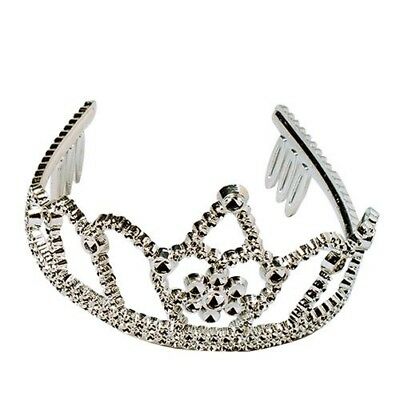-40%
Shop~Morris Tiara Queens Sparkle Sequin
$ 26.4
- Description
- Size Guide
Description
A tiara (from Latin: tiara, from Ancient Greek: τιάρα) is a jeweled, ornamental crown traditionally worn by women. It is worn during formal occasions, particularly if the dress code is white tie.History:
Today, the word "tiara" is often used interchangeably with the word "diadem", and tiara is often translated to a word similar to diadem in other languages. Both words come from head ornaments worn by ancient men and women to denote high status. As Geoffrey Munn notes, "The word 'tiara' is actually Persian in origin—the name first denoted the high-peaked head-dresses of Persian kings, which were encircled by 'diadems' (bands of purple and white decoration). Now, it is used to describe almost every form of decorative head ornament." Ancient Greeks and Romans used gold to make wreath-shaped head ornaments, while the Scythians' resembled a stiff halo that would serve as the inspiration for later Russian kokoshniks. The use of tiaras and diadems declined along with the decline of the Roman Empire and the rise of Christianity.
Late 18th century-present:
In the late 18th century, Neoclassicism gave rise to a revival of tiaras, but this time it was a solely female adornment. Jewelers taking inspiration from Ancient Greece and Rome created new wreaths made from precious gemstones. Napoleon and his wife Joséphine de Beauharnais are credited with popularizing tiaras along with the new Empire style. Napoleon wanted the French court to be the grandest in Europe and had given his wife many fabulous parures which included tiaras.
Queen Elizabeth II is said to have the largest and most valuable collection of tiaras in the world, many of which are heirlooms of the British royal family. She is often seen wearing them on state occasions. The Queen inherited many of them, especially from Queen Alexandra. Queen Mary purchased the Grand Duchess Vladimir tiara in the 1920's. It consists of numerous interlocking diamond circles. Pearl drops can be attached inside the circles or emeralds. Queen Mary had a tiara made for the Delhi Durbar held in 1911 in India. It is now on loan for wearing by the Duchess of Cornwall, wife of Charles, Prince of Wales. Queen Elizabeth II commissioned a ruby and diamond tiara. A gift of aquamarines she received as a present from the people of Brazil were added to diamonds to make a new tiara.
Other queens, empresses, and princesses regularly wear tiaras at formal evening occasions. The Swedish Royal Family have a magnificent collection as do the Danish, the Dutch, and Spanish monarchies. Many of the Danish royal jewels originally came into the collection when Princess Louise of Sweden married the future King Frederick VIII of Denmark. The Romanov dynasty had a superb collection up until the revolution of 1917. The Iranian royal family also had a large collection of tiaras. Since the Iranian Revolution, they are housed at the National Jewelry Museum in Tehran.
Although usually associated with women of reigning and noble families, tiaras have been worn by commoners as well, especially rich American socialites like Barbara Hutton. Tiaras are generally a semi-circular or circular band, usually of precious metal, decorated with jewels and are worn as a form of adornment. (On rare occasions, usually when the actual tiara is exceptionally old and valuable due to its history, gemstones and previous ownership, realistic copies may be made and worn in place of the original due to insurance considerations.) Tiaras are worn by women around their head or on the forehead as a circlet on very formal or high social occasions. Tiaras are frequently used to "crown" the winners of beauty pageants.
During the Victorian Age in the United States, tiaras were being seen on non-royal ladies of means.
“In Paris great aigrette balls were organized by aristocrate families who were proud of their name and their past, such as Dutcesse de Gramount with her ‘Crinoline Ball’ and Princess Jacques de Broglie with her ‘Gemstone Ball’ of 1914. In distant New York, Philadelphia an Newport on the other hand, Mrs. William Astor, Mrs. George J. Gould, Mrs. W.K. Vanderbilt and Eva (Mrs. Edward) Stotesbury entertained with a degree of magnificence which made European balls appear almost insignificant. The moneyed classes of the United States, who had originally raised themselves above their bourgeois origins through their own hard work, set out to rival the historical aristocracy of Europe. In friendly competition with her rivals, the well-to-do American women refused to forgo any of the attributes sanctioned by society. These accessories included country houses imported from Europe complete with ancestral portraits and furnishings, as well as tiaras order from Cartier’s in Paris and later New York.” – Cartier By Hans Nadelhoffer
By the 1920's, the tiara and similar tiara headbands became popular in the United States. They were worn not only with formal ballroom gowns, but became popular with the flappers and their parties.
“
"The 1920's was a period when milliners used their imagination to embrace aspects of dress from nations far and wide. Inspiration was sought from Egypt, China, Japan and Russia. Headdresses including turbans, toques, kokoshniks and tiaras were all reinvented by designers."
”
Costume jewelry tiaras
Tiaras made of plastic, rhinestones, Swarovski crystals, or any other non-precious material are considered costume jewelry. They are worn by women on special occasions such as homecoming or prom and at their quinceañera (fifteenth birthday) or wedding. They are also worn by the winners of beauty pageants and girls dressing up as Disney princesses.
Stage and screen:
Tiaras are often worn by actresses in film, plays, and television. In 2013, Cartier created a replica of the ruby and diamond tiara they had originally made in 1956 for Princess Grace of Monaco for the film, Grace of Monaco starring Nicole Kidman. As Is.
Costume Jewelry. Fake stones.


















